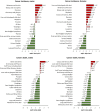Annual Report to the Nation on the Status of Cancer, Part 1: National Cancer Statistics
- PMID: 34240195
- PMCID: PMC8634503
- DOI: 10.1093/jnci/djab131
Annual Report to the Nation on the Status of Cancer, Part 1: National Cancer Statistics
Abstract
Background: The American Cancer Society, Centers for Disease Control and Prevention, National Cancer Institute, and North American Association of Central Cancer Registries collaborate to provide annual updates on cancer incidence and mortality and trends by cancer type, sex, age group, and racial/ethnic group in the United States. In this report, we also examine trends in stage-specific survival for melanoma of the skin (melanoma).
Methods: Incidence data for all cancers from 2001 through 2017 and survival data for melanoma cases diagnosed during 2001-2014 and followed-up through 2016 were obtained from the Centers for Disease Control and Prevention- and National Cancer Institute-funded population-based cancer registry programs compiled by the North American Association of Central Cancer Registries. Data on cancer deaths from 2001 to 2018 were obtained from the National Center for Health Statistics' National Vital Statistics System. Trends in age-standardized incidence and death rates and 2-year relative survival were estimated by joinpoint analysis, and trends in incidence and mortality were expressed as average annual percent change (AAPC) during the most recent 5 years (2013-2017 for incidence and 2014-2018 for mortality).
Results: Overall cancer incidence rates (per 100 000 population) for all ages during 2013-2017 were 487.4 among males and 422.4 among females. During this period, incidence rates remained stable among males but slightly increased in females (AAPC = 0.2%, 95% confidence interval [CI] = 0.1% to 0.2%). Overall cancer death rates (per 100 000 population) during 2014-2018 were 185.5 among males and 133.5 among females. During this period, overall death rates decreased in both males (AAPC = -2.2%, 95% CI = -2.5% to -1.9%) and females (AAPC = -1.7%, 95% CI = -2.1% to -1.4%); death rates decreased for 11 of the 19 most common cancers among males and for 14 of the 20 most common cancers among females, but increased for 5 cancers in each sex. During 2014-2018, the declines in death rates accelerated for lung cancer and melanoma, slowed down for colorectal and female breast cancers, and leveled off for prostate cancer. Among children younger than age 15 years and adolescents and young adults aged 15-39 years, cancer death rates continued to decrease in contrast to the increasing incidence rates. Two-year relative survival for distant-stage skin melanoma was stable for those diagnosed during 2001-2009 but increased by 3.1% (95% CI = 2.8% to 3.5%) per year for those diagnosed during 2009-2014, with comparable trends among males and females.
Conclusions: Cancer death rates in the United States continue to decline overall and for many cancer types, with the decline accelerated for lung cancer and melanoma. For several other major cancers, however, death rates continue to increase or previous declines in rates have slowed or ceased. Moreover, overall incidence rates continue to increase among females, children, and adolescents and young adults. These findings inform efforts related to prevention, early detection, and treatment and for broad and equitable implementation of effective interventions, especially among under resourced populations.
© The Author(s) 2021. Published by Oxford University Press.
Figures




Comment in
-
Cancer Surveillance Opportunities to Meet Prevention and Control Challenges.J Natl Cancer Inst. 2021 Nov 29;113(12):1604-1605. doi: 10.1093/jnci/djab132. J Natl Cancer Inst. 2021. PMID: 34240205 Free PMC article. No abstract available.
References
-
- Sherman R, Firth R, Charlton M, et al. , eds. Cancer in North America: 2013-2017. Volume One: Combined Cancer Incidence for the United States, Canada and North America. Springfield, IL: North American Association of Central Cancer Registries, Inc.; 2020.
-
- Fritz A, Percy C, Jack A, et al. International Classification of Diseases for Oncology. 3rd ed. Geneva, Switzerland: World Health Organization; 2000.
-
- Howlader N, Noone AM, Krapcho M, et al. , eds. SEER Cancer Statistics Review, 1975-2017. https://seer.cancer.gov/csr/1975_2017/, based on November 2019 SEER data submission, posted to the SEER web site, April 2020. Bethesda , MD: National Cancer Institute; 2020. Accessed May 20, 2020.

